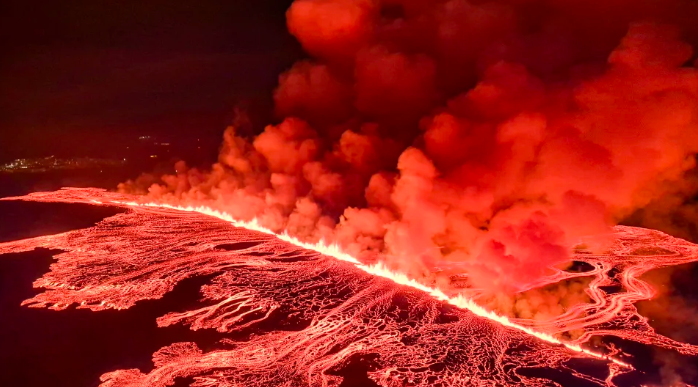Iceland’s Violent Volcanic Eruption
Iceland’s southern region has been plunged into a state of emergency following the fourth volcanic eruption on the Reykjanes Peninsula since December. The latest eruption, which began late on Saturday, has triggered powerful and fast lava flows, prompting the evacuation of the small town of Grindavik and raising concerns about the impact on critical infrastructure in the area.
Lava Reaches Eastern Defenses of Grindavik
According to the Icelandic Met Office (IMO), the lava flows were initially rapid and intense but have since slowed down to a steady pace as of Sunday morning. Despite this, the lava has managed to reach the eastern defenses of Grindavik, a town that has been largely evacuated due to the ongoing volcanic activity.
The IMO reported that the lava was just 200 meters (650 feet) away from the region’s water pipe, which is a crucial lifeline for the residents of the Reykjanes Peninsula. The pipe is located near the Svartsengi power plant, a geothermal facility that supplies hot water to most of the area.
Potential Dangers if Lava Reaches the Sea
Kristin Jonsdottir, the head of department at the Norwegian Meteorological Agency, warned of the potential dangers if the lava, which is flowing southwards, reaches the sea. The interaction between the alkaline lava and seawater could produce harmful chlorine fumes.
Furthermore, she cautioned that “minor explosions” could occur if the lava becomes unstable upon contact with seawater. This interaction could pose significant risks to the environment and the health of nearby residents.
Fissure Activity Dissipates
The initial fissure, which stretched 3 kilometers (1.9 miles) in length, has seen a decrease in activity. All possible preparations have been made to deal with the flow of lava, and the main concern now is the impact on infrastructure.
Reynisson also expressed worry about the accumulation of lava pools near the defenses and warned that all roads leading to Grindavik might need to be closed if the situation worsens.
Most Powerful Eruption So Far
As per the Geophysicist team that conducted an aerial survey of the affected areas, Saturday’s eruption was the most powerful one to date. He observed two lava streams moving westward and southward, with local reports confirming that lava from the southern stream had reached Grindavik’s eastern defense walls.
Gudmundsson also noted the possibility of lava flowing into the sea, but this may not occur if the volcanic activity subsides.
Wider Lava Bed and Protective Embankments
Nordic Volcanological Centre announced the lava bed in this eruption is “significantly wider” compared to the one in February, which caused lava to flow in a similar direction. To mitigate the impact, numerous protective embankments have been constructed around both the town and the power plant.
Iceland’s Volcanic Landscape
Iceland is home to 33 active volcano systems and is situated over the Mid-Atlantic Ridge, the boundary between two of the largest tectonic plates on the planet. The Reykjanes Peninsula last experienced a period of volcanic activity 800 years ago, which lasted for decades.
The current eruption marks the seventh since 2021, and scientists believe that the area is entering a new volcanic era that could persist for decades or even cent.
Month: Current Affairs - March, 2024
Category: International / World Current Affairs








